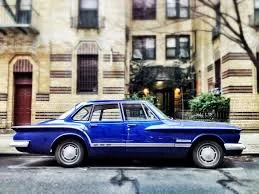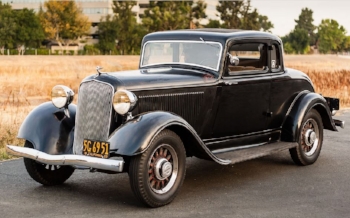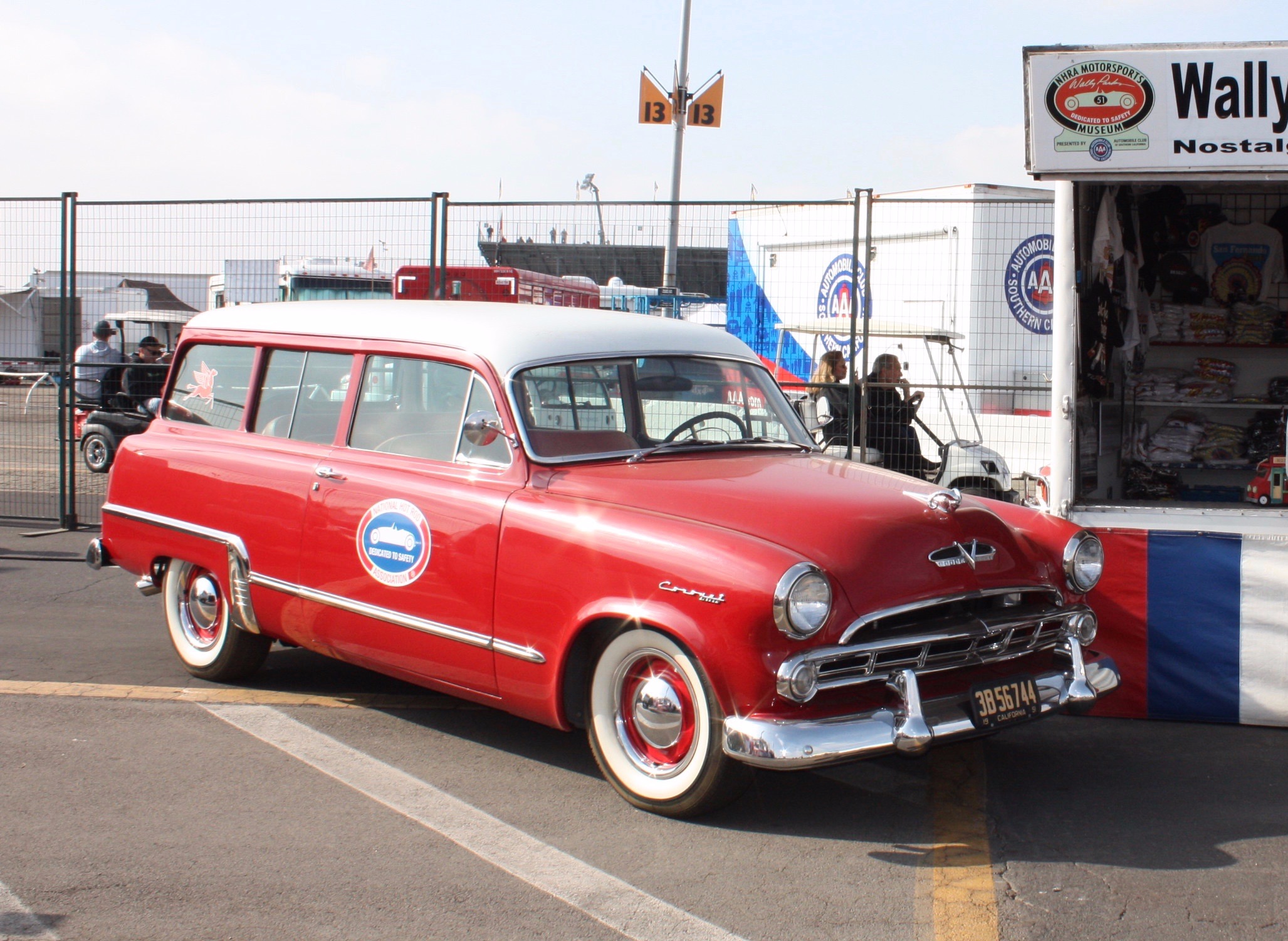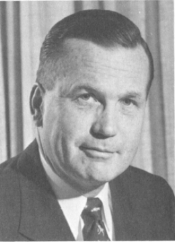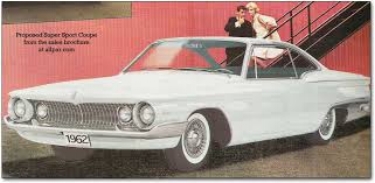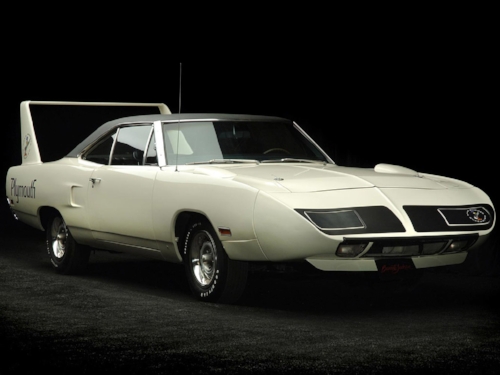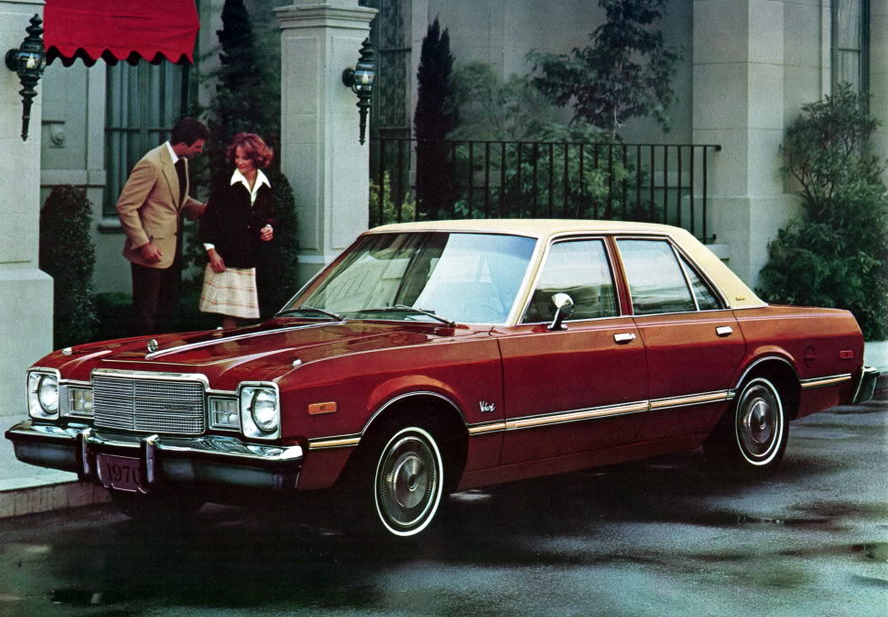Note: This piece currently is a work-in-process
Plymouth
Walter P. Chrysler and the new Plymouth (www.jazzagefollies.com)
Plymouth Sets Sails
The first Plymouth debuted on June 7, 1928 at Madison Square Garden. Plymouth was The then fledgeling Chrysler Corporation’s new “low-priced” make. It was created to compete with Ford, Chevrolet and Willys. The Plymouth was a bit more expensive than the established competition, but it was also roomier, more powerful, and more refined. It had features like hydraulic brakes, and high compression engines, which no other car in the low priced field could boast. Plymouth was a lot of car for the money, a philosophy that would sustain the brand for the next half century.
1928 Plymouth model Q: With the arrival of Plymouth, Detroit's "Big Three" was born. (www.mychurchgrowth.com)
While General Motors was known for its marketing prowess, and Ford for its manufacturing efficiencies, Chrysler Corporation was above all else an engineering powerhouse. That extended to its lowest price offering. Plymouth’s “Floating Power” chassis technology used insulated engine mounts to keep vibration out of the passenger cabin, giving Plymouth a more refined feel than its contemporaries.
1933 Plymouth model pd: style and refinement at a bargain price (www.BringaTrailer.com)
Plymouth was a low priced car packed with tremendous value. Given the Great Depression that had by its 2ndbirthday, swallowed up the US economy, Plymouth was the right car at the right time. It was the only major maker to see sales actually rise during the depression. Within 4 years Plymouth had zoomed to #3 on the sales charts behind Ford and Chevy, giving rise to the term, the Big Three.
Watching the Detectives: Plymouth in the 1930s
All new for 1935, the Plymouth Model PJ was a real sleeper. Its new X-frame chassis gave the car a more controlled ride and better weight distribution. The engine was redesigned for a bit more power and much improved engine cooling and being mated with a fully synchronized gearbox. The PJ was a much improved car and it looked the part, with a sleeker body that adopted the beginnings of aerodynamic streamlining.
1935 Plymouth Model PJ (www.allpar.com)
The Plymouth was an everyman’s car that managed to look a bit menacing. That made it a favorite ride for Hollywood’s everyman heroes. In Howard Hawk’s 1946 film noir classic, The Big Sleep, Humphry Bogart’s Phillip Marlowe drove a prewar 1937 Plymouth P3. As a kid watching the late show on TV, this was one of my favorite movies. So when I discovered what it was Bogie was driving, I associated all tough guy P.Is of the genre with Plymouth coupes.
1937 plymouth P4 DeLuxe: Bogies's choice in the big Sleep (www.imcdb.com)
Apparently I wasn’t alone in linking Plymouths with detective noir. When director Robert Zemeckis chose wheels for his grizzled P.I., played by Bob Hoskins in the 1988 farce-noir, Who Framed Roger Rabbit, he also made the association with Plymouth.
Roger Rabbit drove a ’39 in Who Framed Roger Rabbit (www.joesherlock.com)
The Time when Time Stood Still
Plymouth rolled out its all-new 1942 models a few months before World War II forced the shutdown of all civilian automobile production. It would be almost four years before America’s industrial might would be relieved of its war-time service.
1942 plymouth P-14: The last pre-war Plymouth would have to last a while (www.AACAforum.org)
1948 plymouth: pre war style BEGINNING to look a bit stale (www.automotivetimelines.com)
When consumer production resumed in late 1945, demand for new cars was frenzied. Car-starved consumers would snap up any new car they could find. Carmakers had to ramp up production fast. The most expedient way to dust off their 1942 tooling, swap in some new bits of trim and call them ‘46s. No one would complain that they were getting warmed over 4- year-old cars so long as their odometer read “0.”
And why bother spending on brand new ‘47 or ’48 models either, so long as the sellers-market still raged. Not much needed changing but the VIN numbers.
All that changed for 1949. As supply and demand converged, the automakers where ready with their first new cars of the post-war era. A new Plymouth P-18 full sized car was revealed in March of that year. Unfortunately, that was 6 and 10 months after the respective arrivals of the handsome new Chevys and Fords against which it was supposed to compete. Also unfortunate was that the new Plymouths didn’t look all that new. Chrysler’s chairman, K.T. Keller, refused to follow the longer/lower/wider “fad” as he called it, that the industry seemed so taken with. Chrysler’s cars would stick to proven design philosophies, conservative looks, with plenty of room inside. K.T. Keller was 6’4” and over 300lbs. For K.T, a lot of room was a lot of room. Thus, the 1949 ½ Plymouths were upright and dull at a time customers craved sleek and exciting.
1950 Plymouth P-18: What’s new is old again (www.ColectorCarAds.com)
1950 Plymouth: evolutionary design not keeping up with times
The Plymouth P-17 variant introduced a few months later was more radical, but in the wrong direction. It rode on a wheelbase shortened by 7 inches, making it the Big Three’s smallest car. A decade later the market would embrace the frugal image of a compact, but at the start of the 1950s, bigger was still better. Plymouth was compact before compacts were hip.
The P-17 lasted 3 model years-worth of lackluster sales.
1950 plymouth SpeciaL suburban at 2018 NHRA Winter Nationals (Mal Pearson)
While a small Plymouth wasn’t what the market was looking for, the Suburban station wagon also introduced that year, was a game changer. While the 1950 Suburban is often referred to as the first steel-bodied wagon, it was actually the third such creature. But while both the Jeep CJ-based 1946 Willys and the subcompact 1948 Crosley proceeded Plymouth, these two appealed to more specialized audiences.
But in 1950, it was still those grand woodies that America thought of when they thought of wagons. To ease the transition Plymouth still offered a 4-door woody, despite the death toll sounding for timber. Steel required little maintenance and was safer in a wreck. It was significantly cheaper, too. Steel-bodied Plymouths would finish the year outselling their wooden siblings by almost 6 to 1. Not surprising - but sad nonetheless - Plymouth did not offer an organic wagon in 1951. Woodies of any make were gone after 1953.
1950 Plymouth Special DeLuxe wagon: LAST OF A KIND (WWW.RMSouthbys.COM)
That same year we said goodbye to the Woody, the Plymouth brand celebrated its 25th birthday. It was a subdued affair. Though there was a completely redesigned Plymouth in 1953, no official note was made of the silver milestone. Perhaps it was because both Ford and Buick were celebrating their 50ththat year and Plymouth didn’t want to be thought of as having half the heritage. Customers didn’t take much note of the ’53 Plymouths either, which stayed true to K.T. Keller’s stodgy design philosophy. Something would have to change or Plymouth might not be around for its own 50th.
the 1053 Plymouth: advanced Engineering. Styling; not so much
Awakening: The Exner Era
Virgil M Exner: Chrysler's style chief from 1953 to 1961
1955 plymouth belvadere: plymouth's first v8
1958 plymouth fury: the model of evil in the movie christine
1960 plymouth fury: over the top (www.BringaTrailer.com)
1961 Plymouth: what comes after over the top? Exner's last Plymouth (www.clunkbucket.com)
The Valiant
Many years ago I was out on a date with an artist, a hipster before anyone had thought of the term. I’ve long forgotten her name but not her style. Upon discovering that I knew something about cars, she announced that her current dream car was a 1960 Plymouth Valiant. Really, I asked, not prepared for such a pronouncement but intrigued nonetheless. She liked tail fins, you see, and the Valiant was the cheapest car she knew of that had them.
the 1960 Valiant: tail fins on a budget (www.allpar.com)
By the late-1950s, Detroit had taken note of the Import Invasion. Sales of imported cars, led by the diminutive Volkswagen Beetle, had topped 100,000. It wasn’t until the 1960 model year that the Big Three finally had their new compacts ready to do battle. General Motors unveiled the technically advanced, but not, as it turned out, fully developed, rear-engined Corvair. Ford offered up the simple and austere, yet strangely handsome Falcon. Chrysler’s response was the high-style Valiant, the only one sporting honest to god tail fins.
Big 3s compacts: Corvair, Valiant and Falcon (www.curbsideClassics.com
vs. the DIMINUTIVE Deutschlander
All three of Detroit’s import fighters were about 3/4ths the size and price of their standard sized siblings. The Plymouth, however, had two features that set it apart.
The first standout was that the Valiant was voluptuous. It had not one but two flowing pairs of the aforementioned fins.
Plymouth Valiant: Voluptuous (www.PaulGeorgeDaniel.Wordpress.Com)
The second was the soon to be legendary “Slant Six” engine. Engineers tilted the motor 30 degrees to the right. This positioning allowed for better lubrication, a lower hood line, and a pretty cool nickname. The Slant Six would provide bullet-proof reliability to the frugalest of Chryslers for the next quarter century.
the indestructable chrysler slant six
The Slant Six came in several sizes and power levels. Its top dog variant was the special order Ram Air Hyper Pak, with a 4bbl carb. This setup was very conservativly rated at 148hp and could propel a Valiant to 122mph. To showcase the Hyper Pak, Exner penned his eponymously named XNR sports car, but could not make the case for getting it into production.
Even so, looking at the XNRs luscious lines makes me think that Ex, unlike yours truly, would have gotten a second date with my fin-loving femme.
1960 Plymouth XNR concept (www.CarStyling.RU)
Valiant served – dare I say, valiantly? - for another 15 years. Later versions provided owners with reliable basic transportation - and supplied Plymouth with steady 6-digit sales numbers. As for being anyone’s dream car? Not likely.
1964 Plymouth valiant (www.Transpress.NZ)
1968 Plymouth Valiant (www.allpar.com)
1975 Plymouth Valiant (www.curbsideClassic.com)
Lets Get Small
While “Lets get small” was probably the genius comedian Steve Martin’s greatest routine, getting small didn’t work out so well for the Chrysler Corporation’s new full sized cars of 1962. It was funny, though in a different sort of way. Like watching a multibillion dollar car company slip on a banana peel.
the 1962 Plymouth (www.ModernMopars.com)
It all started on a pleasant spring Sunday in 1960. As the story goes, while attending a garden party, new Chrysler President William C. Newberg overheard then Chevrolet boss, Ed Cole, talking to a companion about a downsized Chevy being developed for 1962. This was alarming news for Newberg, who was in his first few weeks on the job. He was already worried because the economy had not yet recovered from the 1958 recession, and the big, swoopy, freshly redesigned 1960 Plymouths were not being embraced in the marketplace. At the same time, AMC’s irrepressible leader, George Romney, was all over the media claiming that the age of the “Detroit Dinosaur” was at an end. His AMC lineup of nearly exclusively smaller cars was nipping at Plymouth’s heels for the number three spot on the sales charts. All the while industry commentators were suggesting that the consumer’s tilt toward frugality might be permanent. Seeming to confirm this thinking were rumors circulating of a smaller Ford also due out in ’62. And now, word of a smaller Chevy?
William C. Newberg
Fearing that the rest of the market was zigging small, while Chrysler kept zagging big, Newberg could perhaps be forgiven arriving at Chrysler headquarters Monday morning in a panic.
At that time Exner and his team were at work on an all-new full sized line for 1962. It would be a departure from his past themes. The prominent tail fins were gone, replaced with tucked wings swept strait back like a raptor in full dive. The proportions of the car were also swept back, emphasizing a long hood and short rear deck. Originating from prominent headlamps, another pair of tucked wings flowed gracefully into the doors, lending further preeminence to the long wide hood. Between these subtle but elegant style lines was a sleek cabin section featuring side windows that were nearly flush with the doors, like the body of a jetliner. While this is common design practice today, in the early 60’s it was revolutionary. Exner had sought this ‘fuselage’ look for years and it was made possible by a special curved side glass developed by supplier PPG. Ex referred to the new look as “Swept Wing,” and it might well have turned around his and Chrysler’s ailing fortunes.
Proposed 1962 Plymouth S-Body full sized car (www.allpar.com)
1961 plymouth Savoy: Bold but not Beautifull (www.clunkbucket.com)
Then came that fateful Monday morning. Newberg, the Chrysler president, marched into the studios and told Exner and his designers to stop what they were doing and get to work on a crash downsizing program. One stylist who was present that morning called it Chrysler’s “day of infamy.”
The compact 1960 Valiant (www.FiftiesWeb.com)
With about 20 months until the start of the ’62 model year, there was no time to design a new car from scratch. The only viable option was to stretch the compact Valiant platform into a not so full sized full-sized car.
Funds were short. With Chrysler still suffering lingering effects of the recession, the suits from finance were looking over everyone’s shoulders for cost savings. Then Virgil Exner was stricken with a heart attack and could not vigorously fight for his say. With a directive from the president, no money, and their leader laid low, the designers had no choice but to compromise - that dreaded solution that almost never produces a pretty car.
The not so full-sized 1962 Plymouth (www.ClassicCarCatalogue.com)
And it didn’t this time. The Swept Wing styling, so beautiful and flowing on a larger car, now looked awkward and top-heavy on the shorter, narrower body. To make matters worse, cost the accountants killed the PPG curved glass that gave the car’s flanks their contour and helped integrate the body with the greenhouse.
1962 Plymouth Fury Convertible: but Not too bad (www.fiftiesweb.com)
Credit the stylists, however. The results weren’t good, but they weren’t bad either. Given the circumstances of the ’62 Plymouth, “not bad” is as good as one could hope for.
It was much worse for the Plymouth’s sister car, the 1962 Dodge Dart. The impressionist Picasso might have considered the Dart a bit strange looking. One reviewer likened it to an “angry warthog.” You have to wonder with this one if the designers were not venting some of their frustrations.
On the bright side: Smaller means lighter…and lighter means quicker
Despite his heart condition, Virgil Exner protested as vehemently as he could against Newberg’s decision. Americans would return to big cars just as soon as the nagging remnants of the recession were past. As it turned out, Ex was right.
And Newberg? He was as wrong as wrong can be. Nineteen sixty-two arrived and the downsized Chevrolet that he had heard being discussed turned out to be a conventional new compact called the Chevy II. The big Impalas, Bel Airs and Biscanes were as full-sized as ever. The smaller Ford he’d heard rumored was the new Fairlane, slotted between the compact Falcon and the still very big Galaxy. Newberg had made Chrysler zig while the rest of the industry had kept right on zagging.
William Newberg was not around for Ex to say ‘I told you so.” Just months after his decision to get small, Newberg became embroiled in a scandal involving kickbacks and nepotism and was forced to resign. Ex wasn’t around either. Oh, he survived the heart attack, but between the market’s tepid response to his not at all tepid looking 1961 cars, and him publicly referring to the '62s as "plucked chickens," Ex got the sack. too.
1964 Plymouth Fury: A pretty little chicken (www.oldcarsweekly.com)
Exner’s replacement, Elwood Engle was brought over from Ford after he had penned the instantly iconic 1961 Lincoln Continental. Over the next 2 years Engle managed to draw some pretty feathers onto those plucked chickens. Sales grew by over 50%.
For 1965, Engle unveiled new from the ground up, fully full-sized cars. Sale rose another 19%, and Plymouth was again the #3 selling car in America. The brands’ decent into smallness had mercifully come to an end.
1965 Plymouth Fury: The biggest Plymouth yet (www.UniqueCarsandParts.AU)
The Barracuda
The Plymouth Barracuda was introduced on April 1, 1964 but it was no joke. It was a sporty derivative of the tried and true Valiant compact sedan. The Barracuda broke ranks with the vanilla Valiant by sporting a sleek fastback roof, bucket seats, and an innovative fold-down rear seat that created a long flat cavernous cargo area. It might have been the coolest new car of 1964 had not 16 days later Ford introduced… the Mustang.
Comparing the Barracuda to the Mustang was like seeing two movies about the same subject, but one is an art house film, the other a Hollywood blockbuster. You appreciate the Barracuda’s elegant shape as the eye lingers on its many fine details. With the Mustang, you are swept up in the spectacle of it all.
The sales charts, like the box office, revealed America’s preferences. Plymouth made a tidy profit selling 23,000 Barracudas in its abbreviated first year, and a further 65,000 in 1965. Ford sold nearly a million Mustangs it its first 18 months, giving birth to an American icon. Together the Mustang and Barracuda launched a brand new automotive category… and it wasn’t called Fish Cars.
A redesign for the Barracuda came in 1967. Following the Mustang’s lead, the sporty Plymouth no longer bore such stark visual connection to the dull-as-dirt compact sedan on which it was based. It was now a unique line that included coupe, fastback and convertible version. The Barracuda’s humble beginnings where still evident to the sharp observer. That wasn’t necessarily a bad thing. With less mass and slightly smaller dimensions Barracuda was a bit lighter and nimbler than the Mustang.
Nineteen sixty-seven also saw the debut of Chevrolet’s sporty Camaro. Mercury brought out the elegant Cougar that was based on the Mustang. Pontiac introduced its sexy Firebird that year, too.
Even though the Barracuda was the first of the sporty compacts, it seemed to always be playing catchup.
The 3rd generation Barracuda of 1970 finally caught up. This writer would say it left Mustang and the others in the dust. All visual links to the humble Valiant were obliterated. There was not a wrong line in this car. The ’70 Barracuda was arguably the most refined and handsome iteration of Chrysler’s new aircraft inspired “fuselage” look.
Unlike some of its competitors in the pony car field, with tasteful application of graphics and accessories, even tarted up versions of the Barracuda were still gorgeous. It may have been the best looking pony car ever.
The trouble with perfection is that it is fleeting. The trouble for Barracuda’s good looks came from Detroit’s requirement that each model year bring updates and “improvements.” Nineteen seventy-one brought a quadra-lamp faceplate, complete with a set of teeth in its grill that would do any predatory fish proud…but art it wasn’t.
The revised car seemed slightly cartoonish compared to the sublime beauty of the year before. Two decades later, however, this made it the perfect choice of wheels for the slightly cartoonish namesake star in TV’s Nash Bridges. What is it about network television that seeks to put undercover detectives in the most over covercars imaginable?
Given the unfortunate timing of its earlier ancestor, it was fitting that just as the Barracuda was reaching its full potential in 1970, its target market turned to decline. When work began in the late 1960s on this the latest, greatest and unfortunately last Barracuda, the Pony Car category accounted for over 8% of the new car market. By its introduction in 1970, the sector was grazing below 6%. A year later, insurance companies had caught on. As rates on performance cars soared, sales correspondingly cratered.
The Plymouth Barracuda was king of the ‘fish cars’, always a bit out of synch with the market. It was fierce and predatory creature of the deep, swimming in a little pond on the Mustang ranch. Exactly 10 years after the first one rolled off the line, the last Barracuda was built in the Spring of 1974.
The Muscle Car Era
Elwood Engle: Replaced Exner in 1961
1966 plymouth GTX: might be the best looking muscle car ever
Fast, too. Richard Petty's #43 Plymouth dominated NASCAR, earning him the NICKNAME, King Richard
In the early 2000s TV show, Angel, the title character played by David Boreanaz fights evil on the streets of LA. He also happens to be a vampire with a soul. Angle’s choice of car reflects his dual nature. Why a 1967 Plymouth GTX? He might have a soul, but he’s still a badass.
1969 Plymouth road runner: dragster speed with taxicab trim
If you were a carmaker in 1970 and you wanted to get the attention of a 10-year old boy, I can say from experience that this car will do the trick. Nothing else looked like a Plymouth Superbird. That long, sloped nose and towering rear wing were stunning. They weren’t just for show either. The reductions in drag and increase in downforce meant one thing; speed… lots of it. The Superbird was the fastest car on the big oval tracks of NASCAR. Too fast, as it turns out. The aero tech allowed the Superbird to out run period tire technology. Race rules were changed in 1971, setting NASCAR down a regulatory path that would eventually lead to the cant-tell-em-apart-without-a-program race cars of today.
1970 plymouth superbird: No wall flower here (www.Supercars.com)
Thanks to John Lasseter and the folks at Pixar Animation, 10 years olds of the Seventies aren't the only ones to be wowed by the Superbird.
The Last Plymouth
The last car ever to be conceived from the beginning as uniquely a Plymouth was the 1970 Duster. The awesome 3rd generation Barracuda, also debuting that year, was larger and more expensive than its Valiant-based predecessor. At the same time, the boxy compact Valiant possessed not one iota of excitement. Between these two extremes Plymouth planners found a gap in their lineup for an inexpensive 2-door with a bit of style. Their problem was that the new Barracuda consumed a good portion of Plymouth’s 1970 product budget (This after an expensive redo of the full sized line the previous year) Given only minimal funding for the effort, designers had no choice but to use more that 90% of the dreary Valiant and try to turn it into something lively. They decided to leave the chassis, interior and front half of the car alone and put all their efforts into one of the prettiest ass-jobs in the annals of the automobile.
Plymouth Valiant’s boring backside
plymouth duster: one cute ass (www.Valiant.org)
The Duster was an instant hit. Plymouth dealers moved 217,000 of them in its first year – six times as many as the previous year’s 2-door Valiant. Part of Duster’s popularity came from the variety of guises in which it could be ordered. Interiors ranged from vinyl bench seats, to cloth buckets with center console, full instrumentation and a fold down rear seat. Full or half vinyl roofs could be ordered, with or without a sliding steel sunroof. Buyers could power their Dusters with anything from a budget-priced granny-mobile 125hp Slant Six, right up to a mighty 275hp V8-powered Duster 340.
The Duster 340, as it turns out, was one of the most potent machines of the muscle car era. With its combination of low weight and high power, 340s turned in some of the fastest times on the drag strip.
Everyone who lived through the 1970s, it seemed, had a Duster or knew someone with one. Over 1.3 million Dusters would find homes over its 7 year run. Speaking of the everyman, in the cynical 1990s sitcom, Married, With Children, shoe salesman Al Bundy, played by Ed O’Niell, was a pitiable, if not exactly lovable loser whom life has passed by. If only the 20-year old Duster he drove had been a 340. Al would have been a lot happier.
A Squashed Bug on America’s Windshield
The Duster kicked off the new decade with such promise, but things went downhill from there. The 1971 Plymouth Cricket imported from Britain was the first gentle shove.
The 1971 Cricket would join a veritable swarm of small cars buzzing the U.S. market in that year. While the Volkswagen Beetle was still the queen of the hive, the Japanese makers were preparing for their next wave. Ford had its cute and perky Pinto on the way, as Chevrolet was readying its tech-on-a-budget Vega. Even quirky AMC had its quirky Gremlin. Projections called for the blossoming category to tally sales well in excess of a million cars.
America’s Small cars: Pinto, Gremlin and Vega
Plymouth wanted desperately to join the fun, but didn’t have the money to develop a small car of its own. At the time Chrysler Corporation was in a financial bind of its own making. Several management blunders in the 1960s had left it strapped for cash. One of those was the decision to purchase Great Britain’s Rootes Group, overseers of the once respected - but no longer - Sunbeam and Hillman brands. Like a staph infection is a byproduct of poor hygiene, the Plymouth Cricket was a byproduct of Chrysler’s hurried quest to become a multinational automaker.
Possibly thinking that two wrongs might equal a right, Chrysler decided to appropriate the Hillman Avenger sedan from its new portfolio of British crap. They slapped a Plymouth badge on it and, voila, they had a small car for the U.S. at a fraction the cost.
Cricket looked pretty good…from a distance (www.CarBuzz.com)
The Avenger was a rather average British car made at a time when British cars were on average pretty bad. After eight decades of designing and building cars to inhabit an island in the North Atlantic one might think that that British engineers would have found a way to keep those cars from rusting. Think again. Avengers/Crickets began to disintegrate on their assembly line in Glasgow, Scotland, and did not stop until they were piles of red dust on the floors of their owners’ garages. Before oxidizing into nothingness, Crickets provided their owners with no pleasure whatsoever. The Hillman 1500cc OHV engine didn’t take well to U.S. emission controls. Sputtering and stalls were common occurrences. When the engine did work, it propelled the Cricket from 0-60mph in only slightly less time than one of those endless matches of the sport with which it shares a name. Fit and finish was abysmal and creature comforts were nonexistent. Owning a Cricket meant spending your drive time in the penalty box.
Hood up; a Common sight (www.barnfinds.com)
Predictions about the 1970s small car market were correct…for some at least…for a while. The Beetle faded away, but not before rising to a level of cultural icon. The Vega sold 2 million copies - before their engines seized up, or melted into puddles of aluminum. Ford moved almost 3 million Pintos - before quite a few of them burst into flames when rear-ended. The Japanese offerings got better and better and came to dominate the market.
And what of the Cricket? Plymouth’s 3,500 dealers managed to move just 28,000 Crickets in 1971, and half that many in 1972, before the plug was pulled. That is an average of less than 6 cars per year for each dealer…on whose showroom floor you could hear the real crickets chirping.
plymouth cricket hops the pond
The Last Muscle Car
The tumultuous seventies were never officially called a depression - unless of course you sold American cars for a living. Throughout that decade, the U.S auto industry was under assault from hostile forces on every front. Angry Arabs cut off the oil (Twice!) that powered Detroit’s mighty V8s. Federal bureaucrats ran amok with safety, economy and emissions regulations, at a time when automakers were ill-prepared to meet them. Imported cars gained favor with the American consumer. All the while inflation wracked a flaccid economy. Fast, refined and cheap - everything Plymouth had come to stand for the last 20 years - suddenly had turned against it.
Plymouth muscle made its final stand in 1975, giving us what was arguably the last true muscle car. Given recent gas lines, its likely very few of the 7,183 Road Runners built that year were ordered with the biggest block V8 with 4bbl carb and dual exhaust. That top mill was down to (only) 400 cubic inches, and boasted barely ½ the horsepower of just a few years ago. And still it managed only 11mpg. Considering the alternatives of the day, this less muscular muscle car was still the fastest fat guy around.
Plymouth's last muscle car (www.BringaTrailer.com)
Free Fall: The Plymouth Volare
Plymouth Volare: Just like Dad’s (Plymouth advert circa 1976)
As a teenager, our sorry family fleet consisted a 1973 Torino station wagon, a 1974 Chevy Vega, and my dad’s brand new 1976 Plymouth Volare. Given such a sampling of mid-seventies crud, I naturally thought the Volare was a fairly decent car. Alas, it wasn’t. The Volare was probably the most memorable Plymouth of the 1970s - for all the wrong reasons. It was a memory most Volare owners - including my dad - would like to expunge. It was the most problem-plagued, recall-ravaged car in history (before handing that rusty crown to GM’s X-Car compacts five years later) Volare is Italian, meaning ‘to fly.’ But within a year or two of its introduction in 1976, the name came to mean, ‘I got stuck with a lemon.’
Out with the old, In with the new (Plymouth advert circa 1976)
It didn’t have to be that way. The Volare - and its almost identical twin, the Dodge Aspen - were on the cutting edge of a new breed of compact cars. Along with the Ford Granada and the Cadillac Seville, the Volare was what advertising types were calling ‘precision sized.’ The Volare was engineered for efficiency. It was only an inch or two larger in any dimension than the 6-year old Valiant and Duster it would replace. But because of its more aerodynamic shaping and a 25% increase in glass area, it looked much larger.
Volare felt larger, too. It had a newly designed transverse torsion bar suspension for a big car ride, and something called “Iso Clamps,” which were basically rubber cushions in between the spring perch and the frame to reduce vibration. Techie sounding stuff like that must have confused period car magazines enough not to notice the most vague, centerless steering feel in the history of the automobile. The Volare was awarded the 1976 ‘Car of the Year’ award.
But Plymouth executives hadn’t even finished measuring for their new trophy shelf before the Volare’s many problems began to reveal themselves. The cost of developing the Volare, along with meeting new emission and safety regulations, all amidst a brutal recession, had left Chrysler’s corporate coffers pretty bare. Deperate for cash and sure they had a winner on their hands, the company’s top brass pushed to get the Volare into production six months early. This was done mostly by cutting corners on pre-production testing procedures - over the protests of Chrysler’s production people. Such a practice rarely results in a happy ending. This would be no exception.
Especially If you like rust and stalls (Plymouth Advert Circa 1979)
Volare-eating gremlins soon emerged from their hiding places. The first to appear were failing seatbelt tensors and issues with the fuel system. Then came the faulty steering columns, corroding brake lines, missing heat shields on the muffler, and upper control arms that separated from the frame. The kicker-in-the-ass-er came when every single front fender on the more than a million 1976-77 Volares and Aspens had to be replaced because they weren’t galvanized and lacked inner linings. The several hundred million dollars Chrysler might have gained by rushing the Volare to market was obliterated by the several billion dollars that recalls cost the company. Billions that might have come in handy when by late 1978, the firm was forced to go to the government with hat in hand begging for a loan to avoid bankruptcy.
a Volare Jolly on Fantasy Island (www.jalopnik.com)
Anyway, did I mention that it came in a station wagon? The Volare wagon boasted the best ratio of space to size of any American car, and was probably the closest thing America had to Volvo’s venerable longroof. Even so, it might have been a stretch to call a Volare Wagon the stuff of fantasy...
…unless of course you’re the producers of the 1977-84 TV show on ABC, Fantasy Island. Each week, a lordly, all-knowing, slightly creepy gentleman named Mr. Roarke, played by longtime Chrysler spokesman Ricardo Montalban (fine Corithian leather, anyone?) granted wishes to a procession of well-heeled visitors played by minor TV actors and has-been former stars. Mr. Roarke and his tiny sidekick, Tatoo, shuttled these sorry souls around their tropical island fantasy in custom Surrey-style Plymouth Volares. Given the Volare’s propensity to desinigrate, combined with a tropical island climate, and this chopped up wagon might have been more believable if it had had doors, but no fenders.
Speaking of Volares on the tube (Just one more, I promise) Despite the fact that nearly all them have worn out, rusted away, or have been junked, a whole new generation of Americans can now know the joys of this unappreciated car. They need only to tune in to the Fox primetime cartoon, Bobs Burgers. The title character’s ’78 Volare Wagon seems to have held up pretty well. It probably helps that this one was made of digits in modern Hollywood…not of steel on a 1970s Chrysler assembly line.
Bob’s Volare on Bob’s Burgers (www.jalopnik.com)
My original assessment as a teenager of my dad’s Volare may not have been too far off the mark (especially given that I wasn’t the one who had to bring it to the dealer every other month). Despite being blamed for bringing Chrysler Corporation to near financial collapse, once the bugs - ok, infestation of nasty, chewing, biting bugs - had been fixed, the Volare really wasn’t an altogether terrible car. How’s that for a tombstone inscription:
The Plymouth Volare
1976-1980
“It wasn’t altogether terrible”
The Lee Iaccoca Era
1978 Plymouth Horizon
1979 Plymouth Tourismo
1981 PLYMOUTH reliant K: the first k-car poses with its proud papa
1984 plymouth voyager mini van: changed the way a generation did roadtrips
1992 Plymouth Acclaim
1992 Dodge Spirit
Daimler-Chrysler and the Death of Plymouth
could there be hope?
No; the chysler pt cruiser Cudda, shudda been a plymouth
1999 plymout prowler: a parting gift to loyal plylgrims
